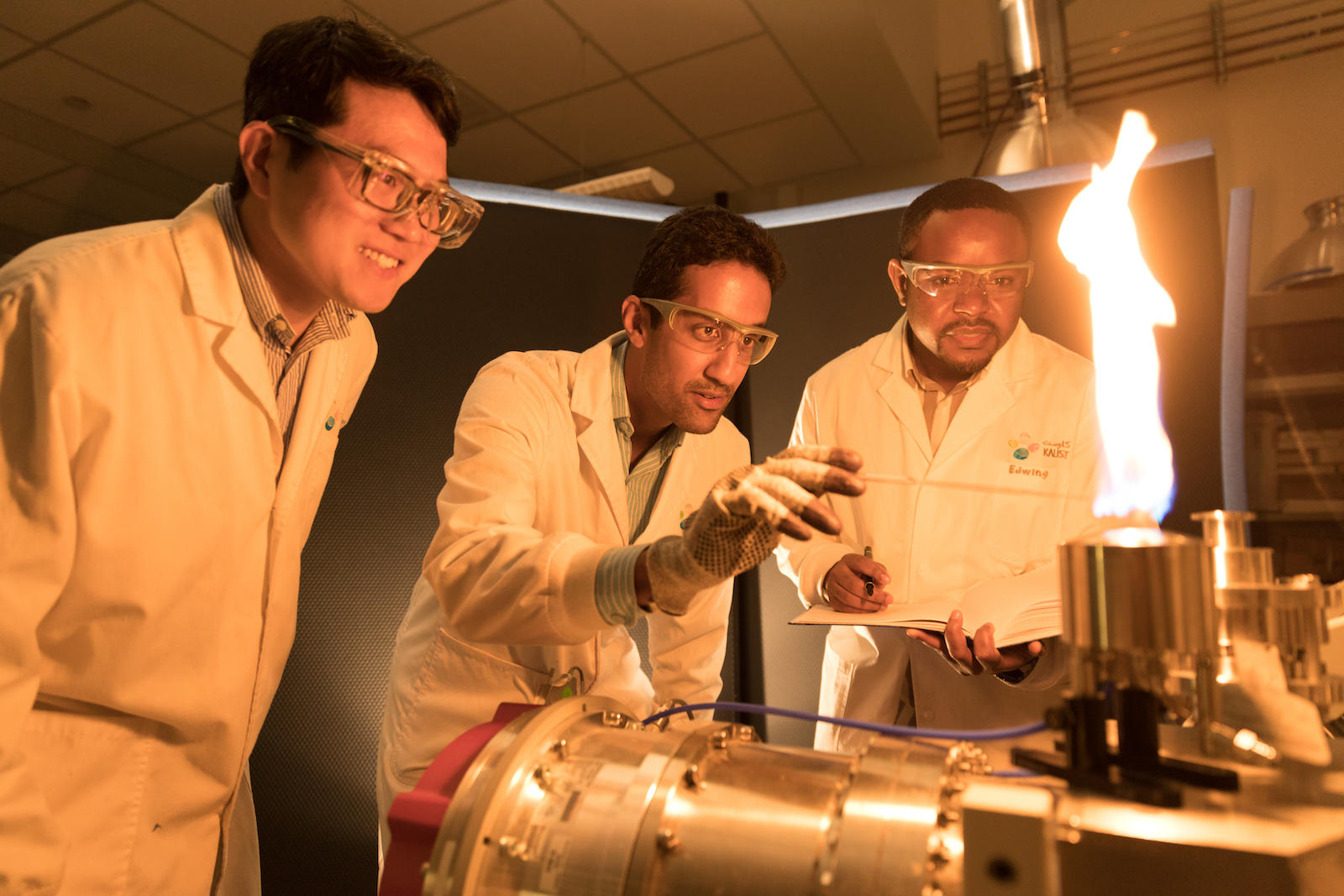Green Hydrogen’s Time is Now

(From left to right) Research Scientist, Zhandong Wang; Associate Professor and Associate Director of the KAUST Clean Combustion Research Center, S. Mani Sarathy; and KAUST Ph.D. alumni and Professor at the University of Jeddah Adamu Alfazazi. File photo.
-By S. Mani Sarathy
For years, hydrogen has been the forgotten clean energy source. Since it was first proposed as a renewable energy source decades ago, things like hydrogen fuel cells have failed to catch on, even as other sources of green energy generation like wind and solar have become more widespread. But thanks to some recent advances in technology and other global factors, including important work done by KAUST scientists and the fuel source's importance in governmental plans to fight climate change, hydrogen may be about to get its moment in the (metaphorical) sun.
A critical part of the renewable energy mix
Although hydrogen is considered a clean energy source, the most common method of production today involves natural gas, meaning the process isn't completely free from fossil fuels and greenhouse gas emissions. This method is often referred to as grey hydrogen, and a blue version uses filters to capture greenhouse gases released during the process.
However, green hydrogen is created with renewable energy, meaning the entire process is carbon neutral and more sustainable. As the cost of renewable energy comes down, green hydrogen production will be more affordable. Green hydrogen is expected to be cost competitive with grey hydrogen within 10 years and 20-40 percent cheaper by 2050, according to Bloomberg New Energy Finance.
That is why regions with a lot of wind and solar, like Saudi Arabia and the American Southwest, will be critical as green hydrogen production is developed and refined, and it's why KAUST scientists have been leading research on green hydrogen for years.
In addition to the work being done on KAUST campus, the university has also partnered with NEOM, a futuristic region on the Red Sea that will be powered entirely by renewable energy. Green hydrogen will be an important part of NEOM's economy, so hydrogen innovations over the coming decades are necessary.
Producing renewable hydrogen
In green hydrogen production, a process called electrolysis employs an electric current to split water into hydrogen and oxygen in an electrolyzer. When hydrogen is produced this way, the only byproduct is water, yet it has the potential to provide clean energy for manufacturing, transportation, and more. However, today's water electrolysis technologies are capitally intensive and require high-purity, desalinated water, which is scarce in desert regions.
KAUST researchers are investigating methods of directly electrolyzing seawater to avoid the need for desalination. In addition, research conducted on novel and durable materials for electrolyzers is helping lower the cost of these systems. To optimize the operation of electrolyzers with intermittent renewable energy resources, KAUST researchers are developing tailored artificial intelligence algorithms for process control and optimization.
In addition to electrolysis, KAUST scientists are working on other ways to use hydrogen once it is produced. A major challenge with hydrogen is that it cannot be transported easily, so one solution is to convert hydrogen into fuels and chemicals that can be more easily transported.
Green hydrogen can be converted to carrier molecules such as ammonia, methanol, and formic acid, for example. KAUST scientists are researching the production and utilization of various hydrogen carrier molecules for industry, power generation, and mobility applications.
These advances in production are bringing the green hydrogen sector to a point where it is far more economically viable.
Decarbonizing transportation
One of the major use cases for green hydrogen is in decarbonizing transportation. While adoption of electric cars is encouraging, there are some elements of transport—marine shipping, heavy trucking, even airplanes—that we can't electrify with current technology.
While hydrogen fuel cells could work in some of these sectors, such as trucking, there is far more potential in E-fuels—synthetic fuels that result from the combination of green hydrogen and captured carbon dioxide.
E-fuel is how green hydrogen will help nations meet their ambitious climate goals. For example, to meet the goals of the European Green Deal, the transport sector needs to cut its greenhouse gas emissions by 80% to 95% by 2050.
It will be difficult, if not impossible, for nations to meet their ambitious climate goals through electrification alone. To close the gap, KAUST researchers are working intensively on the production of renewable transport fuels as well as on their utilization in high-efficiency propulsion systems.
Green hydrogen for the future
To get green hydrogen technology where it needs to be, it will require commitments from government in terms of funding and regulations. And governments are recognizing hydrogen's importance.
Last year, the U.S Department of Energy pledged 100 million over five years to advance hydrogen and fuel cell technology research and development. Additionally, the U.S. government has indicated that within a decade, green hydrogen should be accessible at the same cost as conventional hydrogen.
Green hydrogen is also a critical part of the European Green Deal, the goal of which is to establish a carbon neutral economy by 2050. Saudi Arabia is taking a leadership position in the hydrogen economy with continued investment in large-scale industry projects and technological R&D.
It will take bold action and the decarbonization of many industries to achieve the goal of limiting global temperature rise this century to below 2 degrees Celsius. Green hydrogen can be the vehicle for that change. The time is now to make green hydrogen a more important player in the clean energy mix.
Related
- KAUST professors honored with Combustion Institute's Research Excellence Award
- Earthshot Prize enlists KAUST to save the planet
- Winning the race against climate change

